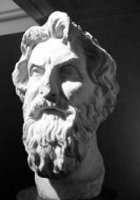
Worksheets and No Prep Teaching Resources
Reading Comprehension Worksheets
Ancient Greece

Ancient Greece
 Worksheets and No Prep Teaching Resources Reading Comprehension Worksheets Ancient Greece |
 Ancient Greece |
| edHelper's suggested reading level: | grades 9 to 11 | |
| Flesch-Kincaid grade level: | 9.1 |
| Print Aristarchus (font options, pick words for additional puzzles, and more) |
| Quickly print reading comprehension |
| Print a proofreading activity |
|
Aristarchus
By Vickie Chao |

|
 1 In history, we all have heard that a Polish astronomer named Copernicus (1473 - 1543) proposed the idea that the Earth rotates and revolves around the sun. That groundbreaking heliocentric (sun-centered) theory became one of the most important scientific hypotheses ever made. But, surprisingly, it was nothing new! More than 1,700 years earlier, a Greek astronomer named Aristarchus (310 B.C. - 230 B.C.) made the same claim. So he was, in fact, the first person to correctly state what we know is true today.
1 In history, we all have heard that a Polish astronomer named Copernicus (1473 - 1543) proposed the idea that the Earth rotates and revolves around the sun. That groundbreaking heliocentric (sun-centered) theory became one of the most important scientific hypotheses ever made. But, surprisingly, it was nothing new! More than 1,700 years earlier, a Greek astronomer named Aristarchus (310 B.C. - 230 B.C.) made the same claim. So he was, in fact, the first person to correctly state what we know is true today.| 1. At the moment that we can only see half of the moon (as it appears to us in its phase of first or last quarter), its angular distance from the sun is 87 degrees. 2. The diameter of the sun is 18-20 times the diameter of the moon. 3. Likewise, the distance of the sun from the Earth is 18-20 times the distance of the moon from the Earth. |
 |
Create Weekly Reading Books
Prepare for an entire week at once! |
| Leave your feedback on Aristarchus (use this link if you found an error in the story) |
 |
Ancient Greece
|
 |
High School Reading Comprehensions and High School Reading Lessons
|
 |
Social Studies
|